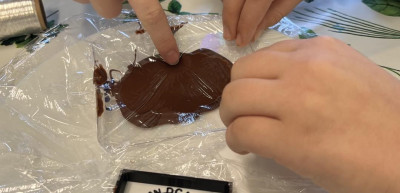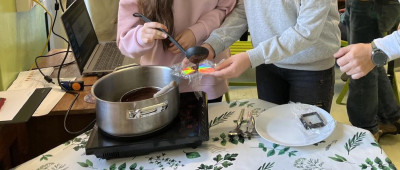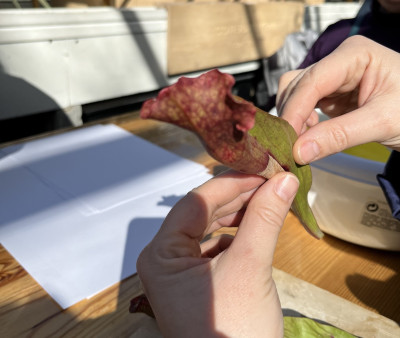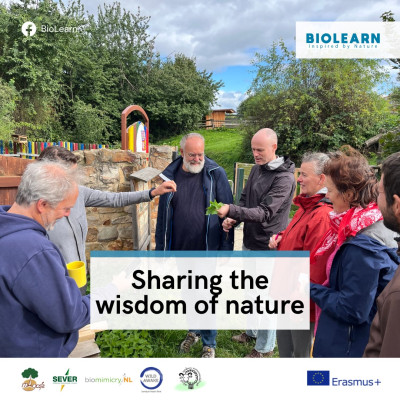Partners gather in Slovakia...to make chocolate
Recently we were in Slovakia for our education project BioLearn. We also visited an eco-school there. Professor Michal did a great job explaining the difference between creating color with pigments or with structure (as regularly happens in nature) and the effects on the living environment. Then the students got to work with chocolate, and colored them by manipulating its structure. Super nice. Do it too? Check out the activity "Colors without dye": https://biolearn.eu/nl/future/biomimicry-stories. Or do one of the many other experiments.

Learn by making chocolate?
This ale️ is not a fairy tale about Karlík and the Chocolate Factory, but one of many biolearning lessons.
Our colleagues visited a primary school in Nové Dubnice (Slovakia) within the project “Biolearning for future”. Teacher Michal Richter showed foreign partners a demonstration lesson on structural colors. Students learned about the differences between structural and pigment paint and their effects on the environment. Then they made rainbow chocolate in peacock tail colors
Biolearning is an interdisciplinary way of education that comes from observation and understanding the principles of how our nature has been functioning for 3.8 billion years. On the website BioLearn or on the website www.biolearn.eu you will find in addition to lessons with rainbow chocolate many other lessons and teaching materials for biolearning.

Teachers getting excited as biomimicry boxes arrive
"I'm looking forward to the inspirational books and the gecko tape. I'm curious to see what suggestions the kids will have for using it. I think we'll try experiments with diffraction gratings and splitting light first," says Ivana Mikušová, headmaster of ZŠ s MŠ Slatina nad Bebravou.
The interest of educators in biomimicry education from the four pilot schools in Slovakia is great and encouraging. Do you know why? Because after half a year of pilot testing, they see that kids enjoy experiments, and find biomimicry education useful in terms of exploring practical applications of natural science for a sustainable and healthier life.
And what's new in the Biolearn Forthe Future project in the last few weeks? In addition to translating materials for the website into Slovak, we have held three meetings with educators from pilot schools.
We asked how the activity testing was going, but most importantly we introduced possible tools and teaching aids in the BioLearn box: e. g. models of natural organisms that inspire innovations, a gecko tape, Shinkansen model, water-repellent shoe spray based on the lotus effect, UV marker with torch as well as various cards, pictures and biomimicry books for the 8-12 age group.

The first biomimicry box
Yesterday we introduced the first Biomimicry box in Slovakia at the Gymnázium Jána Adama Raymana in Prešov, which will make discovering inspiration from nature in school lessons even more interesting.
The box contains natural models (pictures or animal models), but also examples of innovations.
We also tried our first touch with nano tape, inspired by the gecko's superpower to "stick" to different surfaces thanks to thousands of microscopic hairs on its feet.
Biomimicry pilot days
The pilot Biomimicry Days were full of exploration, learning from nature and outdoor education
What is Biomimicry Day? It's an event run in schools where students aged 8-12 can try out varied activities with elements of inquiry-based learning. The aim is to discover a whole new way of looking at nature as a source of knowledge and inspiration for innovation.
The pilot Biomimicry Days, implemented in four schools across Slovakia, have shown that the combination of nature and scientific innovation is very exciting for young people. Pupils first learned what biomimicry is as a new scientific approach and then explored the powerful strategies of plants and animals from which we humans have already taken inspiration for inventions in the field of functional materials, design or medicine.
And which activities were especially attractive for pupils? For example, how the spider web inspired the glass that protects birds from collisions or the hydrophobic surface of the lotus leaf with its microstructure, mimicked by material engineers to produce innovative waterproof jackets without using chemical impregnation. But the most attractive biomimicry exemplar was the bat (in the picture), an inspiration for better echo-locators.
The National Biomimicry Days will take place around Europe from April to June 2024. The Centre of Environmental Activities from Slovakia, together with partners from the Czech Republic, Hungary and the Netherlands, are currently finalizing the methodological materials for their implementation.

Learning from Hortus
One of the most inspiring experiences during the study trip in the Netherlands was a guided tour in a botanical garden Hortus. A group of teachers from Slovakia made a tour of a greenhouse with tropical plants. Later on, their task was to explore a pitcher plant in detail, and identify its specific features. Using a knife, magnifier glass and microscope, they made a detailed description of the plant. Finally, their task was to make a proposal for a bio-inspired innovation. The education team implemented the biomimicry activities exactly as they normally do with 9-12 years old kids. It all worked very well, and as you can see in the picture, our teachers managed to come with a proposal for an innovative surface of water pipes that could reduce blockages. Thanks a lot, Hortus Botanicus Amsterdam, and great many thanks, BiomimicryNL.

What is the goal of BioLearn?
How to describe the goal of the BioLearn partnership in a few words? This has been a task we have been puzzling over for the last few weeks. Out of several proposals, this slogan finally won out: Sharing the wisdom of nature
Do you like it or can you think of something better? Please, Feel free to share in the comments.

What does a bio-inspired meeting look like?
All a-buzz
Rather than learning about biomimicry, the BioLearn partners used biomimicry to work more effectively together. Learning from how nature so often collaborates, for example flowers and bees, partners cross-pollenated each other’s biomimicry stories.
“Our work is lifted to a new level” said project manager Éva Neumayer from Magosfa Alapítvány (Hungary).

